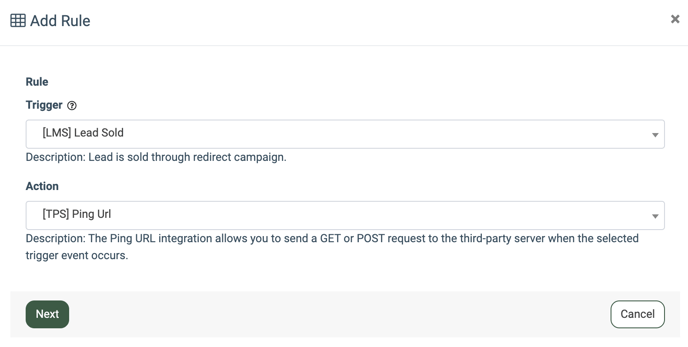Event Tracking Type: Ping URL
The Ping URL tracking type allows you to send a GET or POST request to the third-party server when the selected trigger event takes place.
Read more about the Event Tracking feature and its configuration in the “Event Tracking (LMS / Call Logic)” Knowledge Base article.
This rule can be configured at the Product, Campaign, and Publisher levels.
Read more about setting up the Tracking Rule on the Product level in this Knowledge Base article.
Read more about the Tracking Rule setting up at the Campaign level in this Knowledge Base article.
Read more about setting up the Tracking Rule on the Publisher level in this Knowledge Base article.
To create this tracking rule, fill in the following fields in the “Add Rule” pop-up window:
- Trigger: Select the event that triggers the action:
- [LMS] Lead Sold: The lead is sold through the Campaign.
- [LMS] Lead Rejected: The lead is not accepted by any Campaign.
- [LMS] Post Reject: The post was rejected (for Ping-Post products only).
- [LMS] Campaign Rejected: The Campaign has rejected the lead.
- [LMS] Publisher Earning Received: The Publisher has received earnings.
- [LMS] Campaign Sold: The lead was sold to the Сampaign.
- [LMS] Revenue Ping Back: The revenue pingback has been sent.
- [LMS] Lead Offer Received: The lead status changed to "Offer Received" after a successful ping (for Ping Post Products only).
- [LMS] Form Loaded: The form is loaded.
- [Call Logic] Lead Sold: The lead was sold to the Publisher.
- [Call Logic] Lead Rejected: The lead was rejected by the Publisher.
- [Call Logic] Campaign Rejected: The Campaign has rejected the lead.
- [Call Logic] Campaign Accepted: The Campaign has accepted the lead.
- [Call Logic] Campaign Sold: The lead was sold to the Campaign.
- [Call Logic] Publisher Earning Received: The Publisher has received earnings.
- [Call Logic] Buyer Response: The Buyer has answered the call.
- [Call Logic] Disposition Updated: Buyer Disposition has been updated.
- [Call Logic] Publisher Earning Adjusted: Lead Adjustment happens.
- [Call Logic] Lead Return: Lead Return happens.
- [Call Logic] Lead Partial Return: Lead Partial Return happens.
- [Call Logic] Duration To Sell Reached: The lead has reached the "Duration to sell" time.
- [Call Logic] AMD: Answering machine detected on the buyer's side.
- [Call Logic] Revenue Postback: Revenue Postback sent.
- [Call Logic] Callback Initiated: The callback is initiated.
- [Call Logic] Callback Failed: The callback failed.
- [Call Logic] Callback Failed With Busy: All redial attempts have failed with the status Busy.
- [Call Logic] Callback Failed With No Answer: All redial attempts have failed with the status Non-answered.
- [Call Logic] Callback Answered: The callback answered.
- Action: Select the “[TPS] Ping Url” option.

Once you select the preferable event, click the “Next” button to proceed with the setup.
The “Trigger Settings” block allows you to set up additional filters for the selected event. The filter fields are optional. If no filters are set up, the action will be triggered for all the leads that fit the event trigger.
Depending on the user role, platform, and configuration level, the following filters for trigger settings are available:
- Method: Select the Method (POST/FORM).
- Publisher: Select the Publisher.
- Publisher Exclude: Select the Publisher to exclude from the rule.
- Channel: Select the Channel.
- Channel Exclude: Select the Publisher Channel to exclude from the rule.
- Call Tracking Pool: Select the call tracking pool (available only for Call Logic triggers).
- Source: Select the Source.
- Source Exclude: Select the Source to exclude from the rule.
- Buyer: Select the Buyer.
- Campaign: Select the Campaign.
- Pingtree: Select the Pingtree.
- Price Restrictions: Select the Price restrictions (Price is greater than 0, Price is greater than a certain value, Price is greater than or equal to a certain value, Price is lower than a certain value, Price is lower than or equal to a certain value, Price range inclusive). Note: The “Price range inclusive” value is available only for the “Lead Sold” and “Campaign Sold” triggers.
- Price Restriction Value: Enter the price value.
- Min Price: Enter the minimum price value to trigger the rule by the price range (available only for the “Price range inclusive” value in the “Price Restrictions” field).
- Max Price: Enter the maximum price value to trigger the rule by the price range (available only for the “Price range inclusive” value in the “Price Restrictions” field).
The “Action Settings / Ping Url” block allows you to configure the action required for the rule setup:
- Method: Select the request type (Get / Post / Delete / Put / Patch).
- URL: Enter the request URL as provided in the example using the required placeholders. To view placeholders, click the “Show available placeholders” button.
- Content-Type: Select the data format to transfer. (application/x-www-form-urlencoded, application/json, application/xhtml+xml).
- Do Not Encode Placeholders in Url (NOT SAFE): Select the “Yes” option to skip encoding of the placeholders.
- Use Twig Engine: Select the “Yes” option to use the Twig Engine.
- Body: Enter the parameters you want to transfer. To view placeholders, click the “Show available placeholders” button. To validate JSON in the body of the request, click the “Validate JSON” button. If an invalid JSON is detected, the system will highlight the line where it was detected.
- Basic Auth: Enter the authorization data. Click the “Show Example” to view the required format.
- HTTP Headers: Enter the required HTTP headers. To view placeholders, click the “Show available placeholders” button.
- Ignore SSL Certificate: Check the box to ignore the SSL certificate.
Click the “Save Rule” button to confirm.
-1.png?width=688&height=967&name=unnamed%20(67)-1.png)
